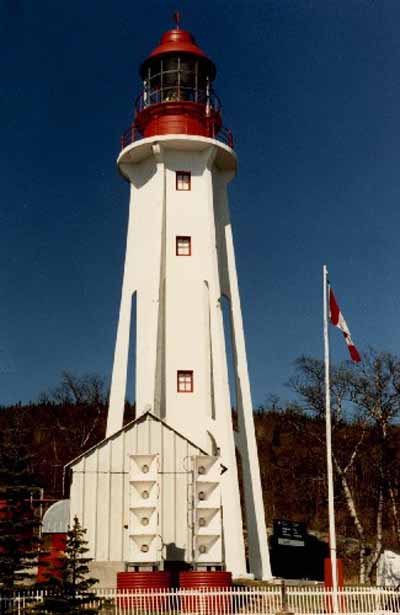Light Tower
Classified Federal Heritage Building
Michipicoten Island, Ontario

General view
(© Canadian Coast Guard / Garde côtière canadienne, 1987.)
Address :
East End Lightstation, Michipicoten Island, Ontario
Recognition Statute:
Treasury Board Policy on Management of Real Property
Designation Date:
1991-09-30
Dates:
-
1911 to 1911
(Construction)
Event, Person, Organization:
-
Lieutenant Colonel William Anderson
(Architect)
Custodian:
Fisheries and Oceans Canada
FHBRO Report Reference:
88-145
DFRP Number:
67652 00
Description of Historic Place
Located on the banks of the Michipicoten Island, the Light Tower is part of a group of buildings that make up a lightstation on Lake Superior. The elegant tapered profile of the concrete tower is emphasized by six flying buttresses, supported by double arches, which surround its central column. Crowning the tall tower is a lantern that sits on a circular concrete platform. The designation is confined to the footprint of the building.
Heritage Value
The Light Tower was designated Classified Federal Heritage Building for its architectural historical and environmental importance. It is an advanced example of the reinforced-concrete, flying-buttress towers developed early in the twentieth century in locations which required strong wind resistance. Its form is an adaptation of a prototype built in Belle Isle, Newfoundland in 1908, and the resulting tapered elegance and height of the light tower distinguish it from its predecessors.
The construction of the Light Tower is associated with efforts to upgrade the quality of lighthouse construction in the early years of the twentieth century, following a long period of restrained government spending.
The tower also enjoys significance for the relatively unchanged nature of the site on which it stands, and for its prominent role in establishing the character of the lightstation.
Sources: Martha Phemister, Lighttower, Michipicoten Island, Ontario, Federal Heritage Buildings Review Office Building Report 88-145; Lighttower, Michipicoten Island, Ontario, Heritage Character Statement, 88-145.
Character-Defining Elements
The following character-defining elements of the Light Tower should be respected.
Key elements that define the heritage value of the Light Tower include: the tower's six flying buttresses (each supported by double arches) flanking a tapered tower of particular elegance; the use of reinforced concrete in the construction of buttresses, permitting a structural response to the increased weight of the improved lanterns and lighting apparatus of the period, and to the horizontally applied wind loads; its location as part of a grouping of buildings added later in time, which provide a good example of adaptation to changing circumstances.
Heritage Character Statement
Disclaimer -
The heritage character statement was developed by FHBRO to explain the reasons for the designation of a federal heritage building and what it is about the building that makes it significant (the heritage character). It is a key reference document for anyone involved in planning interventions to federal heritage buildings and is used by FHBRO in their review of interventions.
The Michipicoten Lighttower was built in 1911 to designs by Lt. Col.
Wm. Anderson of the Department of the Marine. It is the property of Transport Canada, Canadian Coast Guard. See FHBRO Building Report 88-145.
Reason for Designation
The lighttower was designated Classified for its historical, architectural and environmental significance.
Its architectural importance is of a high order. It is an advanced example of the reinforced concrete, flying buttress lighthouses developed early in the 20th century in locations requiring strong wind resistance. Its form is an adaptation of a prototype built in Belle Isle, Newfoundland in 1908. The resulting tapered elegance and height of the lighttower form, distinguish it from its predecessors.
The tower also embodies thematic significance. Its construction is associated with efforts to upgrade the quality of lighthouse construction in the early years of the 20th century, following a long period of restrained government spending.
The tower also enjoys significance for the relatively unchanged nature of the site on which it stands, and for its prominent role in establishing the character of the lightstation.
Character Defining Elements
The tower's architectural significance is primarily embodied in its six flying buttresses (each supported by double arches) flanking a tapered tower of particular elegance. Its formal power has been achieved by the use of reinforced concrete in the construction of buttresses, encircling shell and floor, permitting a fully integrated structural response to the increased weight of the improved lanterns and lighting apparatus of the period and the horizontally applied wind loads.
The design characteristics and materials of the original reinforced concrete elements would be important to maintain as repair work is carried out.
The lighttower has been altered little since its construction in 1911-12. To the fog plant an oil shed and boathouse of 1912 have been added, in 1928, the radio beacon building, a bungalow for the lighthouse keeper and a boat landing in 1953. The buildings together provide a good example of the utilitarian additions and alterations typically experienced by such stations as they have adapted to changing circumstances. It would be important to give every consideration to ways of maintaining these buildings and the relationship between them in future planning of the site.
1992.01.16